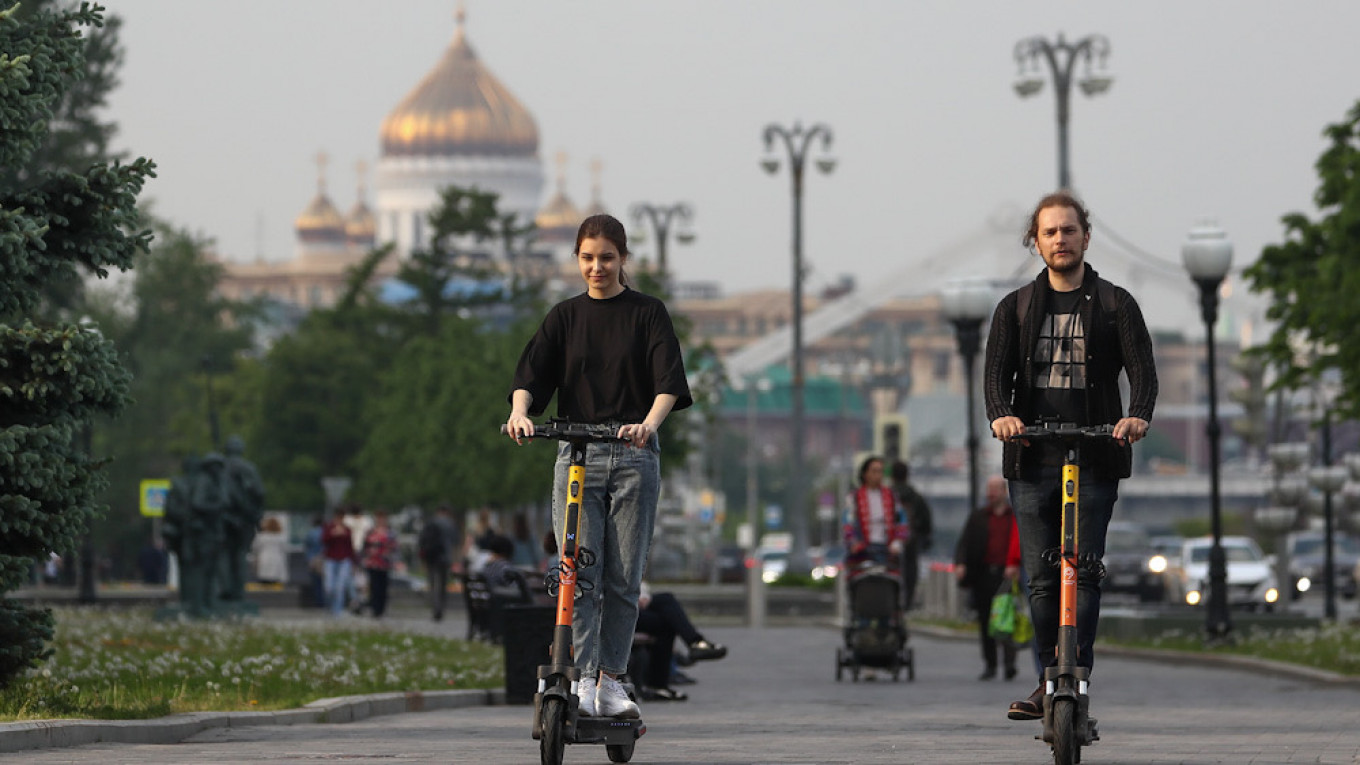Holding on tight to the handlebars of his black electric scooter, 34-year-old IT consultant Evgeni Ovchinnikov, zooms along the embankments of the Moscow River, passing the Kremlin and Red Square on his daily commute to work.
“I have halved my trip to work because of this thing. No more traffic rage either!” he said.
Like many Muscovites, Ovchinnikov has turned to an electric scooter to beat Moscow’s traffic, which consistently ranks among the worst in the world.
Russia is a relatively late bloomer in the market of shareable electric scooters, which are available for rent through a number of different smartphone apps.
E-scooters, fueled by billions in venture capital funding, first spread rapidly across the U.S. and quickly spread to European capitals.
The vehicles, which take up less room than cars or even bikes and are easy to use, are seen by investors as a promising market with significant growth potential. According to the consultancy McKinsey, the sharable e-scooter industry could be worth up to 150 billion euros in Europe by 2030.
Eager to tap into the market, European and Silicon Valley startups have battled over market share in Europe's capitals.
Western companies, however, have not been able to capture the Russian market, which is dominated by Russian startups called Whoosh and Urent.
Both have recently attracted large investments from VTB Bank and Sberbank.
“Russians in cities are rejecting cars and public transport and are leaning towards micro-mobility. There is a clear place for e-scooters in the city,“ said Yulia Kamoilika, spokeswoman for Whoosh.
The company, founded in 2019 by a group of former senior managers of budget airline S7, said that over 3.5 million Russians have so far used its services.
Kamoilika said Whoosh is planning to more than double its number of shareable e-scooters, from 12,000 in 2020 to around 30,000 by the end of the summer.
According to Whoosh’s data, 65% of its customers use the service to commute, indicating that users see it as a viable alternative to public transport and cars.
More specifically, Whoosh brands itself as a “last mile” substitute, saying its customers often use its scooters to get from the metro to work or home.
While Russia, known for its harsh and long winters, isn’t the ideal climate for bicycles and e-scooters, said one of Whoosh’s founders Evgeni Chuiko, they’re still popular.
“We have a long season when e-scooters can be used, from April till November,” Chuiko said.
Tatiana Mikheeva, an expert in urban mobility, said the increasing use of shared electric scooters is part of a growing trend that is seeing Russians embracing sharing services.
Yandex, Russia’s leading technology firm, claims to have the largest car-sharing fleet in the world at 21,000 vehicles, and its Moscow operation far surpasses what European rivals have been able to offer in any single city in terms of size, penetration and success.
The coronavirus has also played a role, Mikheeva said — people have come to prefer individual modes of transport to public ones. And e-scooters are increasingly used by Russian couriers and food delivery companies, a business that has seen significant growth since Covid-19 hit.
Seeing the potential gains, tech giant Yandex is now reportedly also planning to enter the e-scooter market.
According to a report by the Kommersant business daily Monday, by the end of the summer Yandex intends to provide as many as 8,000 scooters in Moscow, St. Petersburg and Kazan.
Growing pains
Not everyone is sold on e-scooters.
“E-scooters have become a danger to the public,” proclaimed a recent news program aired on the prominent Vesti channel, while other media have also been keen to highlight accidents involving e-scooters.
Magomed Kolgaev, the head of urban sharing projects at the Moscow Department of Transport, believes that e-scooters get disproportionately negative attention because of their novelty, while actual accidents remain low.
Both critics and proponents say the accidents that do happen are because e-scooters operate in a legal grey area.
According to current rules, e-scooters are allowed to use cycle paths and bike lanes, and where these don’t exist users are permitted to move along pedestrian paths and sidewalks, which often happens given the limited numbers of bike paths in Russia’s largest cities.
“People ride electric scooters on the sidewalks not because they like it so much, but because they simply have nowhere else to ride,” said Ilya Timakhovsky, development director at Urent.
Proponents of e-scooters now say they hope city authorities across Russia will increase the number of bicycle lanes and dedicate special roads to e-scooters.
Moscow City Council has so far responded by introducing legislation in the center of the capital limiting the speed for rented electric scooters to 15 kilometers per hour, down from 30 to 40 kilometers per hour.
“Scooters need to be given a place in the city. Dialogue between the city, the start-ups, and residents is essential,” said Kamoilika.
A Message from The Moscow Times:
Dear readers,
We are facing unprecedented challenges. Russia's Prosecutor General's Office has designated The Moscow Times as an "undesirable" organization, criminalizing our work and putting our staff at risk of prosecution. This follows our earlier unjust labeling as a "foreign agent."
These actions are direct attempts to silence independent journalism in Russia. The authorities claim our work "discredits the decisions of the Russian leadership." We see things differently: we strive to provide accurate, unbiased reporting on Russia.
We, the journalists of The Moscow Times, refuse to be silenced. But to continue our work, we need your help.
Your support, no matter how small, makes a world of difference. If you can, please support us monthly starting from just $2. It's quick to set up, and every contribution makes a significant impact.
By supporting The Moscow Times, you're defending open, independent journalism in the face of repression. Thank you for standing with us.
Remind me later.







